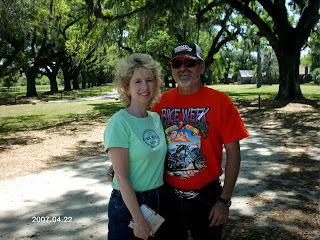

 The next place we went to was nearby to Orton Plantation. The mansion house was built in 1725 by Roger Moore. The Plantation is still privately owned by the Sprunt family and the house itself is not open for tours. However, there are beautiful gardens and grounds that you can walk and gaze upon at your leisure. It was really very beautiful in the fall, but they say in the spring it abounds with color of the many varieties of flowers and flowering trees, so much so, that it “almost hurts your eyes to look at it.”
The next place we went to was nearby to Orton Plantation. The mansion house was built in 1725 by Roger Moore. The Plantation is still privately owned by the Sprunt family and the house itself is not open for tours. However, there are beautiful gardens and grounds that you can walk and gaze upon at your leisure. It was really very beautiful in the fall, but they say in the spring it abounds with color of the many varieties of flowers and flowering trees, so much so, that it “almost hurts your eyes to look at it.” The plantation was once a leading producer of rice in the Carolinas. This area of NC, around the Cape Fear river was the location of many rice plantations and you can still see wild rice grown in abundance in this area as well as this plantation.
The plantation fell into disrepair after the Civil War, but was brought back to it’s former glory by James Sprunt. The Sprunt family still owns it to this day. Though it is not longer a working plantation, today the plantation takes in proceeds from tours of the grounds, and in timber sales from the many pines on its vast acres.
The pictures you see here are the Orton Chapel house that was built by James Sprunt for his wife. The plantation house itself, isn’t it beautiful? Also, there were old graves from family members dating back to the 1700s. One of was an 11 year old girl that died from yellow fever epidemic. Most of these graves were above ground due to the river so close by.




























































Yesterday, a Saturday, 10-31-09, my husband and I embarked on a tour that we have been trying to do all summer and fall and finally were able to do it on the very last day of the tour for the season. We are from southeastern North Carolina and we love history. SE NC is filled with history, especially in the Wilmington area. I happen to have been listening to the radio one day at work and an ad for Dram Tree Tours came on. It was an all day tour on a 14 passenger, air conditioned bus touring some of the best historical sites in and around Wilmington. That sounds like the tour for us!! So after weeks and weeks of trying to get the tour, our schedules allowed us to do so.
The tour included Brunswick Town/Fort Anderson State Historic Site, Orton Plantation, on to unch at Surfer’s Restaurant at Southport, Southport and Ft. Johnston, and Fort Fisher.
This late in the season, there was only one other couple that joined us on the tour, but this did not take away from the tour at all. And this was no ordinary tour guide. This was the founder and owner of Dram Tree Tours, Dram Tree books and publications, and the author of 16 books of the area. He does his own tours and we have never in our lives seen someone that even came anywhere close to being as knowledgeable about the history of any area. This was not a memorized spouting off of knowledge, but the telling of many stories about many people and events of the areas from someone who has studied these places, events, and people for many years and knows what he is talking about. The love of history and the love of this area is very apparent from his tour and we were mesmerized by his tales from the moment we started the tour at 9 a.m. until it ended somewhere around 4:30 p.m. He is from the area. His name is Jack E. Fryar, Jr.
We met in front of Thalian Hall in Wilmington, climbed aboard the bus and off we went to our first stop, Brunswick Town/Fort Anderson State Historical Site. Brunswick Town is a ruin of a town that was founded in 1726 by Maurice Moore. It soon became an official port of entry. It became a center of commerce, immigration and government for the Cape Fear Region as ships from all over the world brought goods into and out of the port. The town played an important role in the Stamp Act Defiance in 1765, and you thought the Boston Tea Party was first. It was not! Brunswick was burned by the Redcoats in 1776. During the civil war however, an earthen fort was built there and it played an important role in the civil war. It was called Fort Johnston. The fort fell to Union forces in Feb. 1865.





Above are some pictures of the ruins of Brunswick Town/ Ft. Johnston. Notice the ruins of the church. You can’t see it on the pictures, but it has the holes, and there were many, many of them, of the bullets of two wars….the Revolutionary war and the Civil war. The larger bullet holes are from revolutionary war bullets as they were bigger bullets. The smaller one are from the civil war bullets. A nice little side note is that Jack, the tour guide got married in the center of that church’s ruins in 2005! I think that’s so romantic. The ruins of the houses clearly show how the houses were laid out. The rocks you see to the foundations of the houses (the only things left of them) came from incoming ships. The ships that came into the areas from other countries used these rocks, that originated from their county were used as ballast. Used in the bottoms of ships if they had a light load in coming over. Upon entering the area in Brunswick, they dumped these rocks here and left them because they didn’t need them anymore as their ships were loaded down with all the things they were taking back. So these rocks were then used for many things, including building houses. So none of these rocks originated in this country.

